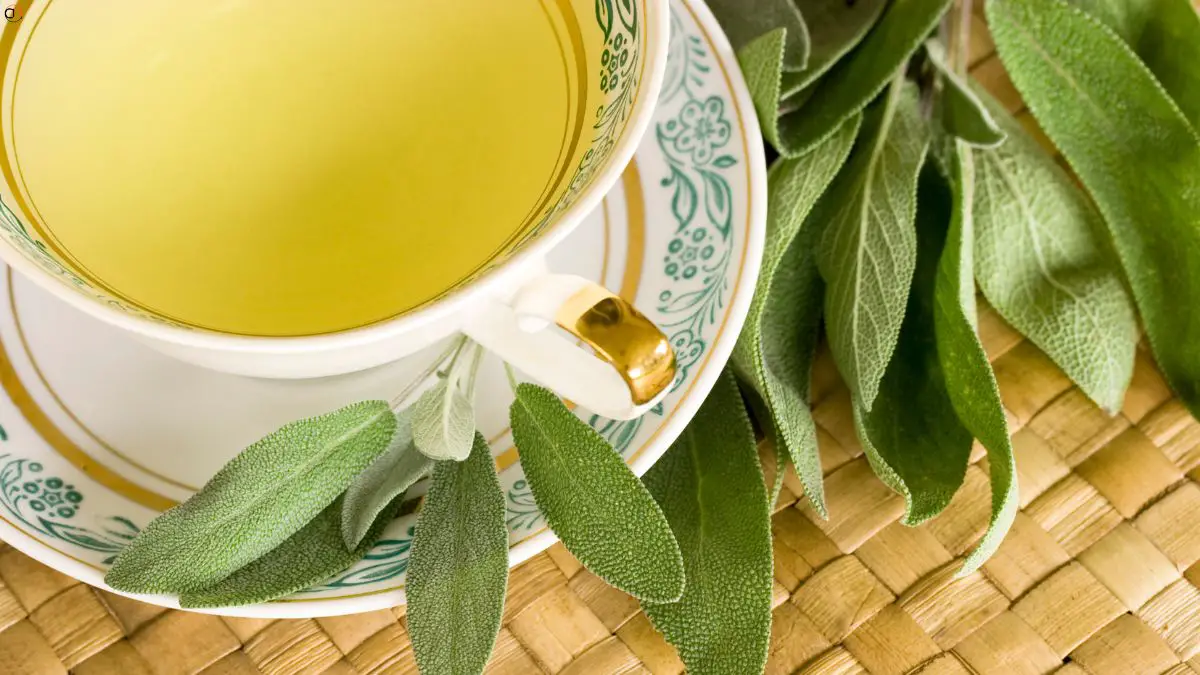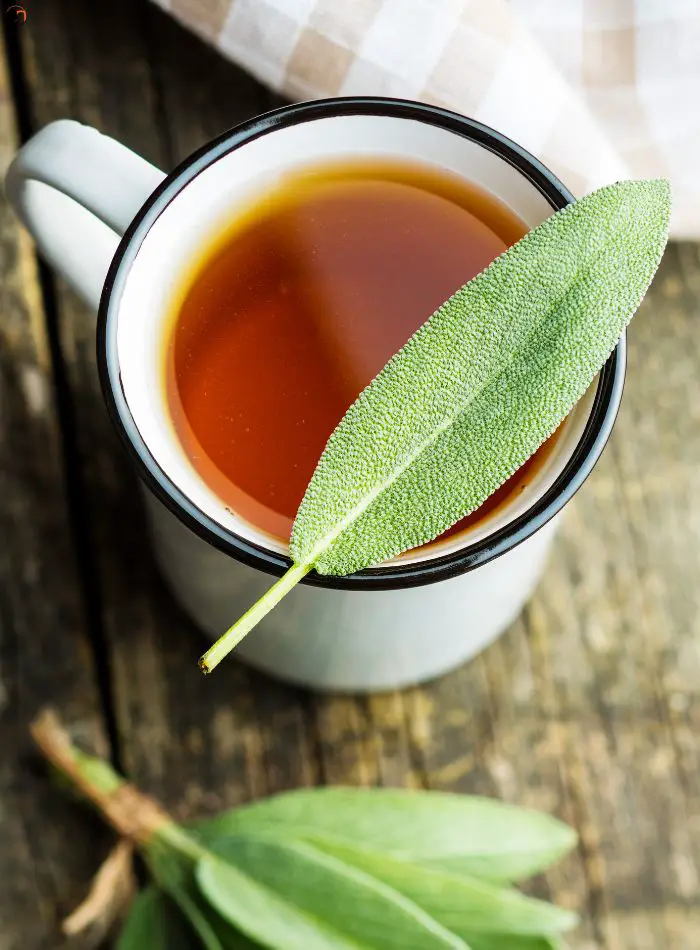Sage is a powerful herb known for its aromatic fragrance and numerous health benefits.
If you’re looking to boost your immune system, aid digestion, or simply enjoy a calming cup of tea, sage tea made from fresh leaves is the perfect choice.
Making sage tea from fresh leaves is incredibly simple and can be done with just a few ingredients you likely already have at home.
How to make sage tea from fresh leaves, using fresh leaves that add a vibrant, earthy flavor to your drink.
Health Benefits of Sage Tea:
Sage tea is more than just a flavorful drink—it’s a powerhouse of health benefits, packed with antioxidants, anti-inflammatory compounds, and essential oils. Here’s a closer look at the many health benefits you can enjoy from drinking this soothing herbal tea:
1. Aids Digestion and Relieves Bloating
Sage has natural digestive properties that help ease bloating, gas, and indigestion. Drinking sage tea after meals can soothe the stomach, promote better digestion, and reduce discomfort. It’s also effective for alleviating nausea and other digestive issues.
2. Boosts Immune Function
Sage is rich in antioxidants like flavonoids, which help protect the body from harmful free radicals. These antioxidants also support the immune system, helping the body fight off infections. Drinking sage tea regularly can help strengthen your immunity and keep you healthier, especially during cold and flu season.
3. Relieves Stress and Promotes Relaxation
Sage tea is known for its calming effects. It can help reduce anxiety, promote relaxation, and improve sleep quality. If you’re feeling stressed or struggling to wind down, sipping on sage tea before bed can help calm your mind and support better, deeper sleep.
4. Packed with Antioxidants
Sage tea is loaded with antioxidants, which fight oxidative stress and help protect the body from chronic diseases and aging. By regularly drinking sage tea, you’re giving your body a natural defense against the harmful effects of free radicals, supporting overall health and longevity.
5. Reduces Inflammation
Sage contains compounds that have anti-inflammatory effects, which may help alleviate inflammation in the body. Whether you suffer from arthritis, muscle pain, or other inflammatory conditions, drinking sage tea may provide soothing relief and support better joint and muscle health.
6. Supports Brain Health
Some studies suggest that sage may improve cognitive function and memory. Drinking sage tea may enhance brain health by improving focus and mental clarity. It may even help slow cognitive decline, making it a great addition to your diet as you age.
7. Balances Hormones
Sage is known for its ability to balance hormones, particularly in women. It may help alleviate symptoms of menopause, such as hot flashes, night sweats, and mood swings. Drinking sage tea can support hormonal balance, making it a natural remedy for those experiencing these changes.
8. Improves Oral Health
The antimicrobial properties of sage can also benefit your oral health. Drinking sage tea may help fight bad breath, prevent gum disease, and protect against oral infections by reducing harmful bacteria in the mouth.
9. Supports Weight Loss
Sage may assist with weight management by helping to regulate blood sugar levels and improve fat metabolism. When combined with a healthy diet and exercise, drinking sage tea may aid in weight loss by promoting a more efficient metabolic rate.
Sage tea is a simple yet powerful way to enhance your health. From supporting digestion and boosting immunity to reducing inflammation and promoting mental clarity, it offers a wide range of benefits
How to make sage tea from fresh leaves:
Making sage tea from fresh leaves is a simple and rewarding process.
With its earthy aroma and soothing properties, fresh sage tea is not only delicious but also packed with health benefits. Here’s a step-by-step guide on how to make sage tea from fresh leaves.
1. Ingredients You’ll Need:
- Fresh sage leaves (about 3–4 leaves per cup)
- Water (1 cup per serving)
- Optional: Honey, lemon, or ginger for added flavor
2. Instructions
Step 1: Harvest or Buy Fresh Sage Leaves
If you have a sage plant at home, pick a few fresh leaves from the plant. Choose vibrant green, healthy-looking leaves, as they contain the most flavor. If you don’t have access to a fresh sage plant, you can find fresh sage leaves at most grocery stores or local markets.
Step 2: Rinse the Leaves
Gently rinse the sage leaves under cold water to remove any dirt, dust, or pesticides. Pat them dry with a clean towel or paper towel.
Step 3: Boil Water
Boil about 1 cup of water in a small kettle or pot. It’s important to use fresh water for the best flavor. If you want to make more than one cup, adjust the amount of water accordingly.
Step 4: Add Sage Leaves to Water
Once the water has come to a boil, turn off the heat. Add the fresh sage leaves to the water. You can either place them directly in the pot or use a tea infuser to hold the leaves, making it easier to strain the tea later.
Step 5: Steep the Sage Leaves
Let the sage leaves steep in the hot water for 5–10 minutes. The longer you steep, the stronger and more flavorful the tea will be. If you prefer a milder taste, steep for about 5 minutes. For a more intense flavor, steep for up to 10 minutes.
Step 6: Strain the Tea
After the leaves have steeped, strain the tea into your cup to remove the sage leaves. If you used a tea infuser, simply remove it from the water.
Step 7: Add Optional Flavorings (Optional)
If you prefer your sage tea a little sweeter or with a hint of citrus, you can add a teaspoon of honey or a slice of lemon. For a spicier touch, a small piece of ginger can be added as well.
Step 8: Enjoy Your Fresh Sage Tea
Stir well and sip your freshly brewed sage tea while it’s still warm. Relax and enjoy the soothing and refreshing flavors of this natural herbal tea.
Tips for the Perfect Sage Tea:
- Adjust Steeping Time: The strength of your sage tea depends on how long you steep the leaves. Experiment with the steeping time to find your preferred flavor.
- Fresh vs. Dried Sage: While fresh sage leaves give a more vibrant flavor, you can also use dried sage if fresh leaves are unavailable. Just reduce the quantity of dried leaves by about half.
- Add a Herbal Boost: You can combine sage with other herbs like mint or chamomile for a unique, multi-herb tea blend.
Making sage tea from fresh leaves is quick and easy, offering a range of health benefits. If you’re drinking it for relaxation, digestion, or to simply enjoy its rich flavor, this herbal tea is sure to become a favorite in your daily routine.
Customizations:
Sage tea is versatile and can be easily customized to suit your taste preferences. Here are some popular ways to personalize your cup:
- Sweeteners: Add honey, maple syrup, or stevia for a touch of sweetness.
- Citrus: A squeeze of lemon or lime can add a refreshing zing.
- Spices: Enhance the flavor with a dash of cinnamon, ginger, or even turmeric for extra warmth and health benefits.
- Herbs: Combine sage with other herbs like mint, thyme, or chamomile for a unique blend.
- Milk or Non-Dairy Options: Add a splash of milk, almond milk, or coconut milk for a creamy twist.
Read Next: How To Craft Rosehip Tea
Last call:
- Making sage tea from fresh leaves is an easy and rewarding way to enjoy a soothing, health-boosting beverage.
- With just a few simple steps—harvesting or purchasing fresh sage, boiling water, and steeping the leaves—you can enjoy a cup of tea packed with antioxidants, digestive benefits, and stress-relief properties.
- For added flavor, customize your tea with honey, lemon, or spices like ginger and cinnamon.
- If you’re new to herbal teas or a seasoned enthusiast, sage tea offers a refreshing, natural way to improve your well-being.
CTA:
- Ready to try making sage tea? Follow the easy steps above and start enjoying this powerful herbal tea today! Join on Pinterest.
FAQs:
Q. Can you make sage tea from fresh leaves?
Yes, you can easily make sage tea from fresh leaves. Simply rinse the leaves, steep them in hot water for 5–10 minutes, and enjoy the soothing tea.
Q. What are the benefits of sage tea?
Sage tea offers numerous health benefits, including aiding digestion, boosting immunity, reducing inflammation, and promoting relaxation.
Q. How long should I steep sage tea?
For the best flavor, steep fresh sage leaves for 5-10 minutes. The longer the steeping time, the stronger the taste.
Q. Can I sweeten sage tea?
Yes, you can add sweeteners like honey, maple syrup, or stevia to your sage tea for a touch of sweetness.
Q. Can I combine sage with other herbs?
Absolutely! Sage pairs well with other herbs like mint, chamomile, and thyme, allowing you to create unique blends.
Q. Does sage tea have caffeine?
No, sage tea is naturally caffeine-free, making it an excellent choice for a relaxing, evening drink.



